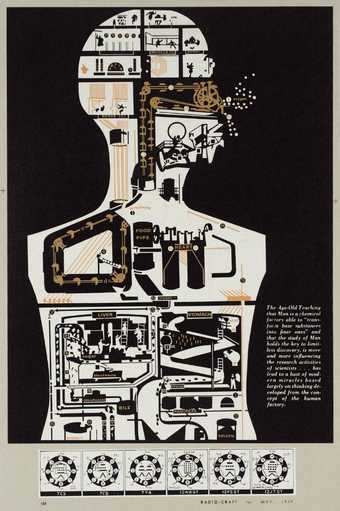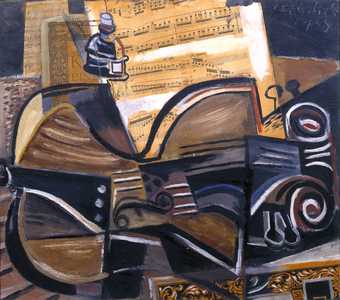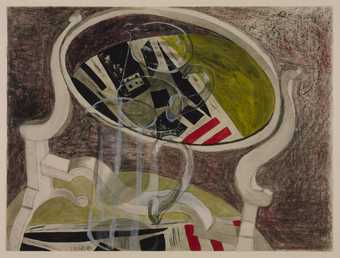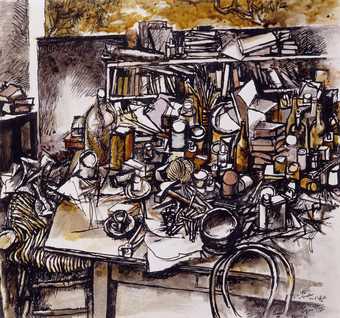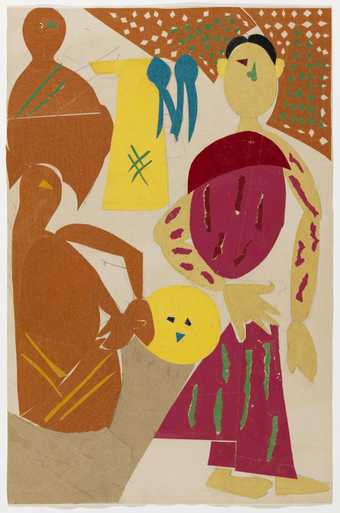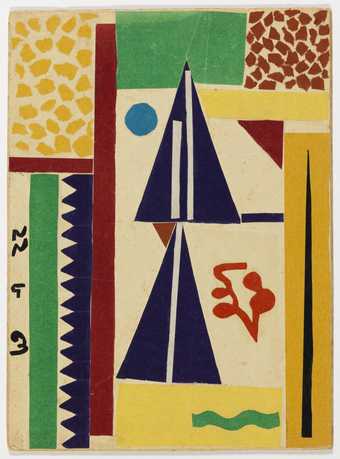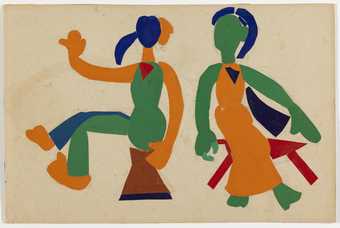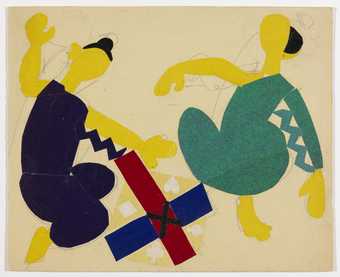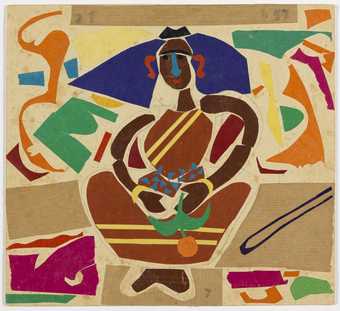
In Tate Britain
Prints and Drawings Room
View by appointment- Artist
- Benode Behari Mukherjee 1904–1980
- Medium
- Paper, printed paper and graphite on paper
- Dimensions
- Support: 260 × 390 mm
- Collection
- Tate
- Acquisition
- Presented by Mrinalini Mukherjee 2014
- Reference
- T14330
Summary
Still Life with Key c.1965 is a paper collage on card that features an array of coloured shapes including triangles, circles, squares, rhomboids and waves. These are laid over a central block of collaged newspaper, which features both advertisements and columns of text. At the top of the composition is a key shape formed from black and pink paper. All of the forms in the work are made from pieces of cut paper in bright hues that are pasted onto beige-coloured card.
Mukherjee turned to paper collage as a medium for artistic expression in 1957 when he lost his sight, at the age of fifty-three. His previous work – executed on paper or banana leaf parchment or as large-scale murals – had been largely representational, with subject matter ranging from flora from his native India to historical themes. His early style was influenced by his interest in calligraphic forms and Japanese ink painting. His sight loss restricted him to working with simple shapes in flat colours, with which he was able to compose complex images from memory. His collages demonstrate a strong a relationship with the late paper cut-outs of Henri Matisse (1869–1954) in their bright, block colours and bold formal arrangement.
Mukherjee had been born with impaired vision, but with his family’s support studied at Kala Bhavan, the art department at Santiniketan, as one of the early students in the artist and writer Rabrindranath Tagore’s (1861–1941) academy. He went on to study in Japan in 1936 and worked in northern India and Nepal. After losing his sight, Mukherjee returned to Kala Bhavan to teach art history, later becoming the academy’s Principal and Professor Emeritus. The art historian K.G. Subramanyan has written of Mukherjee’s sight loss:
Nothing could have been more tragic for an artist at the height of his powers, but he stood up to it with characteristic stoicism. He did not resign himself to inactivity but diverted his creativity in other directions. He made paper collages with the assistance of his associates; he modelled sculptures with plasticine, clay or wax; he built forms with folded paper (which he later used as the basis for a tile mural); he made drawings and prints.
(Subramanyan in Mukherjee 2006, p.309.)
Familiar with both historic and contemporary European art movements, it is likely that Mukherjee would have encountered Matisse’s cut-out paper works, which Matisse made from 1948 onwards. In an autobiographical essay that Mukherjee wrote about his time in Japan in 1937, Matisse and the impressionists are cited as a strong influence on Japanese artists who had studied in or visited Paris. Santiniketan was a cosmopolitan environment, as its founder Rabrindranath Tagore frequently travelled to Europe and interacted regularly with the western art establishment. European and Japanese academics often visited, notably the Italian art historian Giuseppe Tucci in the 1920s, whom Mukherjee mentions in his memoirs. The subjects and themes he chose to represent, from everyday scenes to compositions combining common objects and abstract geometric shapes, also indicate an engagement with the conventions of academic and modernist painting.
In an essay grappling with Indian aesthetics and modernism Mukherjee asked, ‘Where is the meeting point of abstraction and reality? Unless we find this point it will be hard to create a work with the abstract quality. Where they meet appears the world of sadrisya [a term Mukherjee defined as ‘intuition … a kind of cosmic awareness or realisation’], where a work is neither gross fact nor pure experience.’ (Mukherjee 2006, p.154.) He went on to describe how this sense of intuition and mystical, inner aesthetic awareness would allow an artist to realise an object via contemplation instead of observation.
In the same essay Mukherjee wrote: ‘A man who has the power of sight need not be told what light is. And where there is light there is colour.’ (Mukherjee 2006, p.155.) In his collage works he explored colour and abstraction often through essentially figurative compositions. The works were made with the help of assistants at the Kala Bhavan, who cut out shapes in selected colours at Mukherjee’s instruction, which he would then assemble using both intuition and memory. Some of these processes, notably his use of large folded paper shapes for an exterior mural executed in glazed tile, were recorded in Satyajit Ray’s film The Inner Eye of 1973. A group of these collages are in Tate’s collection. Lady with Fruit 1957 (Tate T14329), one of the artist’s earliest collages, has perhaps the most complex arrangement of shapes and colours, highly reminiscent of Matisse’s cut-outs. Two Triangles 1957 (Tate T14326) is a more playful exploration of form, with the use of small scraps of red and yellow paper arranged like mosaics in the two top corners to produce a varied, almost pointillist effect. Mukherjee explained how even abstract forms carry figurative associations: ‘Pure knowledge is entirely a matter of experience – it cannot be demonstrated to others without reference to facts. So even geometric shapes are impure; they are subject to sensation and association.’ (Mukherjee 2006, p.147.)
Other collages such as Conversation c.1960 (Tate T14327) and Game c.1960 (Tate T14328) show two figures interacting. In Conversation two figures are seated on stools, their bodies facing opposite directions; the figure on the left has her torso turned to face the other person, suggesting the movement of twisting around. Mukherjee was concerned with rhythm and tension as expressed in figurative Indian art, specifically in poses derived from classical dance. Through his practice and his expressive exploration of form, even after years of blindness, Mukherjee continued to think about his own understanding of abstraction as a synthesis of experience and necessity. Describing the kind of contrapposto pose depicted in Conversation, he wrote:
Radha milks a cow with her back to us, but turns her face around and looks at the viewer – such astounding anatomy could not be conceived of by the post-Renaissance artists. But in abstraction such concepts could be readily accommodated. In exactly the same way it accepted the abstract quality of colour, that is, artists tried to alter the natural relationship between object and colour. This was referred to as ‘symbolic colour’. So abstraction found general acceptance on all sides although it would be useful to mention here that this was due to the influence of Eastern art.
(Mukherjee 2006, p.157.)
Further reading
Gulammohamed Sheikh and R. Siva Kumar, Benode Behari Mukherjee: A Centenary Retrospective, exhibition catalogue, National Gallery of Modern Art, New Delhi 2006.
Benode Behari Mukherjee, Chitrakar: The Artist, trans. by K.G. Subramanyan, Calcutta and London 2006.
Nada Raza
March 2014
Does this text contain inaccurate information or language that you feel we should improve or change? We would like to hear from you.
You might like
-
Sir Eduardo Paolozzi 28. Man Holds the Key
1972 -
Ceri Richards Still Life with Music
1933 -
E.Q. Nicholson Still Life with Mirror
c.1949 -
Renato Guttuso Still Life in the Studio
1962 -
Benode Behari Mukherjee Three Figures
c.1960 -
Benode Behari Mukherjee Two Triangles
1957 -
Benode Behari Mukherjee Conversation
c.1960 -
Benode Behari Mukherjee Game
c.1960 -
Benode Behari Mukherjee Lady with Fruit
1957

